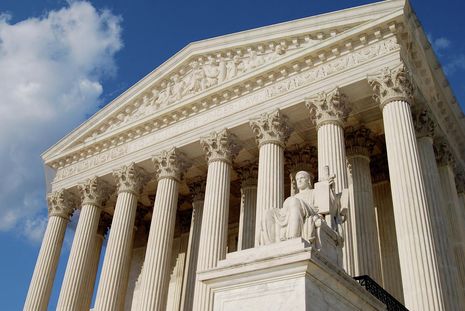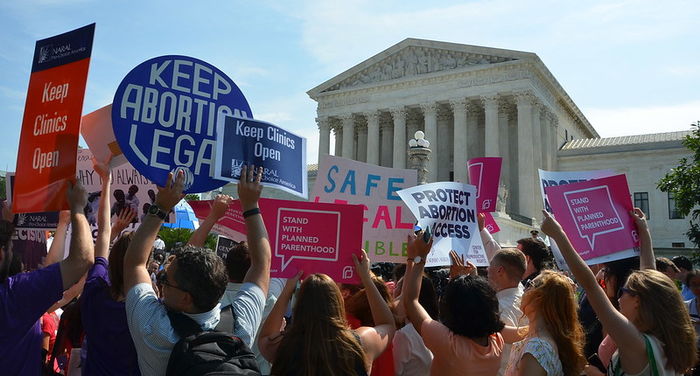The US Supreme Court is problematic beyond Roe v. Wade
Nick Scott observes how The Supreme Court’s sins extend beyond the contentious issue of Roe v. Wade

The nine justices that sit on the Supreme Court of the United States make up the highest court in the most powerful country in the world and hold immense political and social power. In the past few years, the court has moved in a right-wing direction, with controversial decisions on issues like pandemic restrictions, free speech, and most recently abortion. A leaked draft opinion suggests that the court will overturn the 1973 decision Roe v Wade, which held that the constitution protects the right to have an abortion.
A number of the court’s decisions have been unpopular and hard to defend, particularly allowing a radical abortion ban in Texas to go into effect. But I would go further and say that even if you mostly agree with them politically, the court’s conservative majority have abused their powers.
“The court’s conservative majority have abused their powers”
One example is the court’s decisions related to capital punishment. Between 2019 and 2021, the Trump administration executed more people than the federal government had in the previous sixty years – and all with the acquiescence of the court. A number of these executions were allowed to proceed after Trump had lost re-election. Dustin Higgs was killed less than a week before Biden’s inauguration after the court used a rare method to override a lower court and allow the government to immediately carry out the execution. Dissenting Justice Stephen Breyer described the majority as adopting a “hurry up, hurry up” attitude to such cases.
Indeed, the court has used emergency rulings (the so-called “shadow docket”), allowing it to make decisions without a full hearing, in unprecedented ways. In April, the court used these powers (in a 5–4 vote) to order that a Trump rule on water pollution should be reinstated, despite the minority arguing that these powers were meant to be used “only in extraordinary circumstances”.
“The current state of the Supreme Court is the result of deliberate actions of the Republican Party”
The court has gone even further on voting rights cases. In February, it ruled 5–4 that Alabama’s congressional map should be used for the next election despite lower courts blocking it on grounds of racial discrimination. In March the court threw out a map adopted by the Wisconsin Supreme Court on dubious grounds, a sign of increasing hostility to the Voting Rights Act. This with what legal scholar Rick Hasen has called “a bizarre unsigned opinion”.
The current state of the Supreme Court is the result of the deliberate actions of the Republican Party. In March 2016, President Barack Obama nominated Merrick Garland, widely seen as a moderate, to fill the vacancy on the Supreme Court left by the death of Antonin Scalia the previous month. Garland’s nomination had to be approved by the Senate, which was controlled by the Republican Party, with Obama’s Democratic Party in the minority. However, Mitch McConnell, the Republican Senate Majority Leader, refused to even hold hearings on Garland’s nomination, instead stating that the issue should be left until after the presidential election in November of that year.
This blockage led to ties in the court’s votes on a number of important issues, such as immigration policy. Some Republicans even suggested that the seat could be kept open for longer if Hillary Clinton won the presidential election; Ted Cruz said there was “long historical precedent” for a court with fewer justices.
In contrast, after the death of liberal justice Ruth Bader Ginsburg on September 18, 2020, it took the Republican-controlled Senate little more than a month to confirm the conservative (and anti-abortion) judge Amy Coney Barrett as her replacement without any Democratic support, finishing a week before the presidential election (which Republicans lost).
A number of prominent Democratic politicians, such as Elizabeth Warren and Alexandria Ocasio-Cortez, have supported legislation that would expand the Supreme Court, adding four justices to counteract its rightward shift. Court expansion, or court-packing, as its opponents tend to call it, is often seen as a radical, extreme measure. While the size of the court has been changed legislatively several times before, the last time this happened was in 1869. However, since 2016 Republican majorities in Arizona and Georgia have expanded their state supreme courts, and in the past twenty years various other states have seen, mostly Republican, efforts to increase or decrease the size of their highest courts, sometimes explicitly in an attempt to overturn particular decisions like the overturning of a ban on gay marriage in Iowa.
The court’s actions have not gone unnoticed. Polling suggests that Americans are losing faith in the institution, with more than half of voters having “little” or “no” confidence in it. In a speech last year, Justice Barrett said that the court “is not comprised of a bunch of partisan hacks”, but the public increasingly disagrees.
With proposals to reform the court by adding seats or term limits seeming politically non-viable for the foreseeable future, and the justices taking on other contentious issues like gun control, these trends are likely to continue. The nine people who sit on the court serve for life, are unelected, unaccountable, apparently unreformable, and increasingly unpopular – and yet they wield colossal power over the United States. This is a terrible sign for democracy.
 News / Caius mourns its tree-mendous loss23 December 2025
News / Caius mourns its tree-mendous loss23 December 2025 Comment / Yes, I’m brown – but I have more important things to say22 December 2025
Comment / Yes, I’m brown – but I have more important things to say22 December 2025 News / Cambridge welcomes UK rejoining the Erasmus scheme20 December 2025
News / Cambridge welcomes UK rejoining the Erasmus scheme20 December 2025 News / CUP announces funding scheme for under-represented academics19 December 2025
News / CUP announces funding scheme for under-represented academics19 December 2025 Interviews / Politics, your own way: Tilly Middlehurst on speaking out21 December 2025
Interviews / Politics, your own way: Tilly Middlehurst on speaking out21 December 2025










